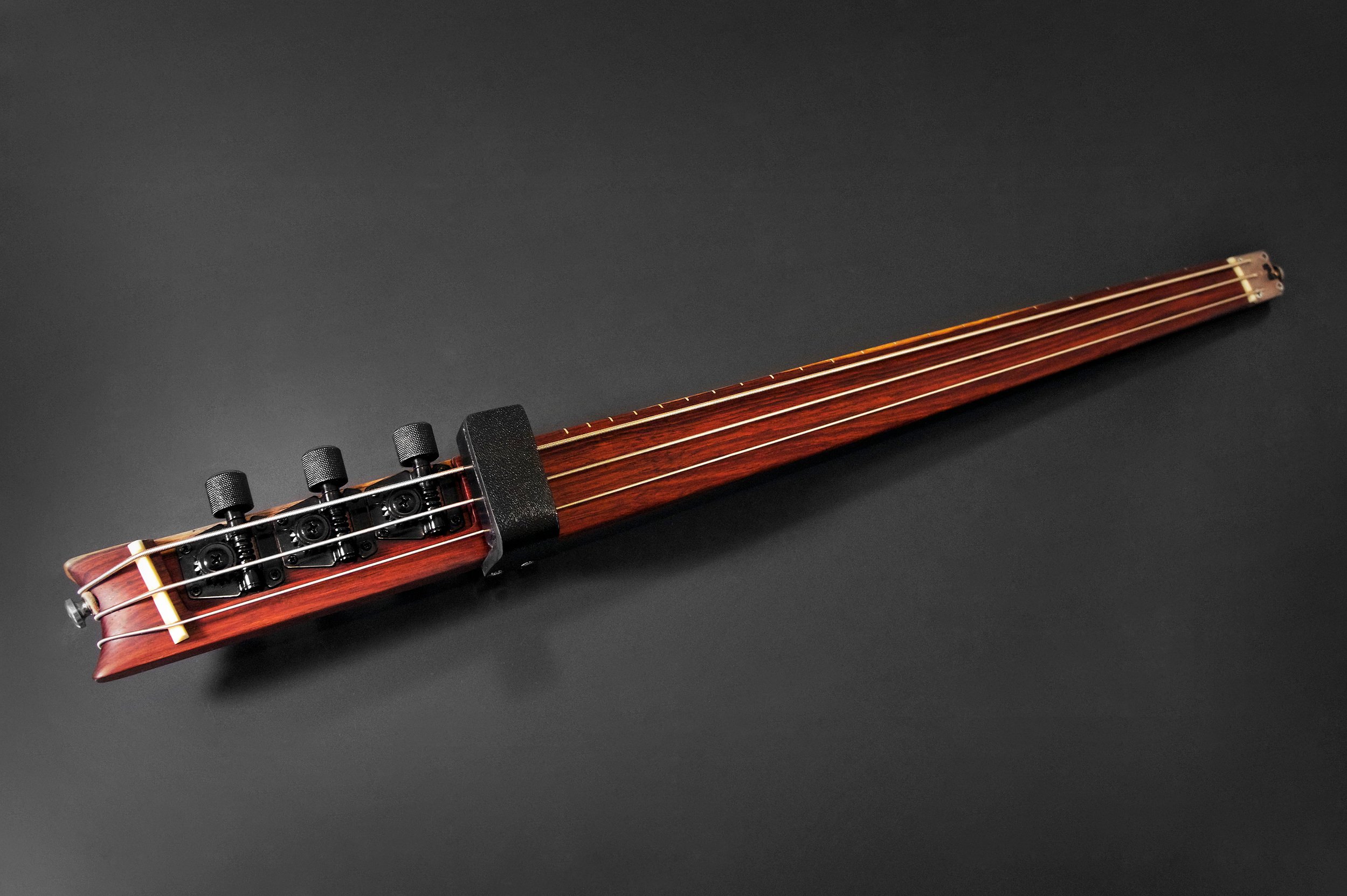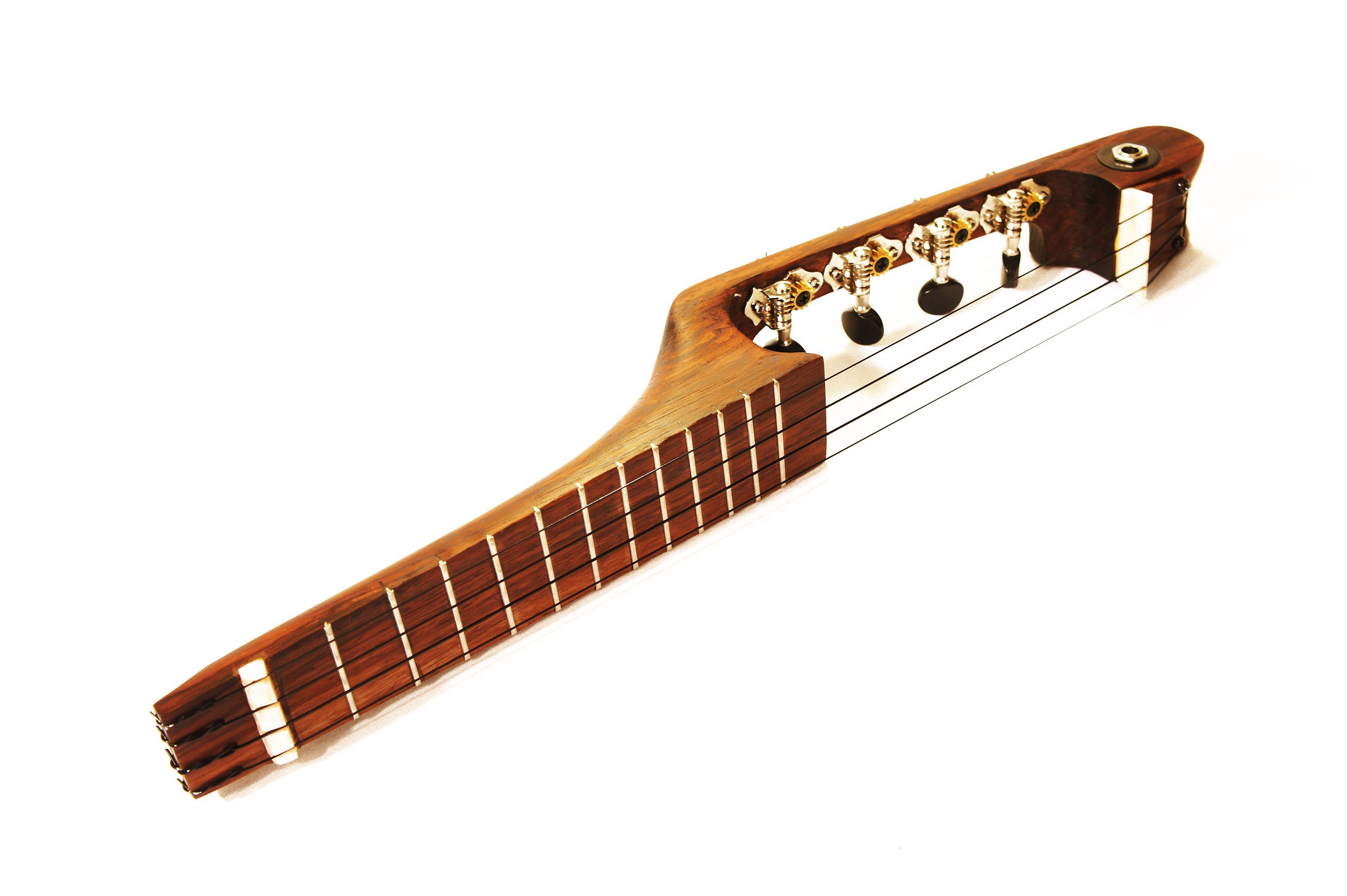Experiments in Luthierie
This body of work is the result of my ongoing fascination with music, form, and the expressive potential of wood. Each instrument in this collection is a one-off experiment, an attempt to reinterpret the traditions of luthierie through a designer’s lens. What unites them is not a singular style or genre, but a shared commitment to hands-on making, sculptural exploration, and sonic playability.
These electric stringed instruments emerged from my workshop over the course of several years, often outside of client work, born from instinct and joy. They range from minimalist travel guitars to angular cellos and violins, and each one reflects a different question I wanted to explore: How much can you subtract from a form before it stops functioning? What happens when you carve an instrument for the body, not just the ear? Can an object be both resonant and radically modern?
At their core, these projects are love letters—to woodworking, to experimentation, and to the deep satisfaction of crafting something that not only looks beautiful, but makes sound.

MUUT Electric Violin
MUUT was my first foray into reimagining classical string instruments, and still one of the boldest. Designed as a sculptural electric violin, MUUT challenged everything I thought I knew about the instrument’s form, ergonomics, and expressive potential. Rather than beginning with tradition, I started with the body: how it’s held, how it moves, and how it feels against the player. The result was a lightweight, radically minimal violin that retains the emotional power of the instrument, while shedding unnecessary mass and ornament.
Carved from hardwood and fitted with a piezo pickup, MUUT is fully playable and stage-ready. Its asymmetrical silhouette is more than aesthetic, it improves balance and comfort, especially during long practice or performance sessions. The project was featured as part of the 2010 Madrid Design Biennial, where it stood not just as a musical tool, but as a provocation: what does it mean to evolve an instrument that has barely changed in centuries?
MUUT was a turning point for me. It set the stage for all the instrument experiments that followed, showing me that good luthierie isn’t just about acoustics or tradition. It’s about rethinking the relationship between form, sound, and the body, and trusting your hands to figure out the rest.
Minimal Bass Guitar
This project began with a simple challenge: how little guitar do you really need to make music? The Minimal Bass is my answer, a stripped-down, single-piece travel bass guitar carved from solid rosewood. It was designed to fit into a backpack, to be repaired with basic tools, and to deliver full-scale tone without relying on traditional forms or materials.
The design is radically reduced: no body wings, no embellishments, just a carefully contoured spine that balances structural integrity with hand comfort. Every curve was shaped with restraint, leaving just enough material to support the neck, pickups, and bridge. It’s fully electric, fitted with standard components, and built to be light enough to take anywhere, but solid enough to hold its own on stage.
This instrument taught me a lot about subtraction, about letting go of familiar proportions, challenging assumptions about playability, and trusting that a form can carry beauty even when it’s barely there. In many ways, it’s the clearest expression of my approach to experimental luthierie: cut until only the essentials remain, then make them sing.
Electric Upright Bass
The Electric Upright Bass was an attempt to capture the soul of the double bass: its warmth, its physical presence, while rethinking it entirely for modern contexts. I wanted something more compact, more transportable, but still capable of delivering the resonance and depth that make the upright bass such a powerful instrument.
This piece blends traditional woodworking techniques with a minimal, architectural structure. The body was reduced to a slender spine and floating tailpiece, supported by a custom stand that holds the instrument upright with stability but minimal footprint. The neck, scale length, and string tension remain true to classical proportions, while the onboard electronics let it plug directly into an amp or interface with no fuss.
What I love about this project is the tension it holds, between presence and absence, mass and minimalism. It plays like an upright, but it travels like a guitar. It’s an instrument made for performers who move, for studios short on space, or for anyone who wants to feel the low end in a more agile form. As with all my luthierie work, it’s an experiment in making tradition lighter, more flexible, and more open to interpretation.
‘Oli Electric Ukulele
‘Oli was born out of a desire to make a lightweight, expressive, and travel-friendly electric ukulele, something you could toss in a backpack, take on a plane, or play at the beach without worrying about fragility or bulk. It’s a compact, sculpted instrument that retains the warmth and charm of a traditional uke, but filters it through a minimalist design sensibility.
Carved from solid wood, the body of ‘Oli is stripped down to its essential geometry, just enough to support the neck and hardware while offering a comfortable grip and balanced feel. It features an embedded piezo pickup for amplification and retains the soprano ukulele’s portability while adding a bold, modern visual identity.
The name “‘Oli” comes from the Hawaiian word for a chant or joyful melody, and that’s exactly what this project was for me: an ode to simplicity, playfulness, and mobility. It’s a reminder that instruments don’t have to be delicate or precious to be loved. Sometimes the most satisfying designs are the ones that invite you to play more and worry less.
Crossbow
Electric Cello
The Crossbow was my take on the cello, not as a historical artifact, but as a modern sculptural object built to resonate both visually and sonically. I was drawn to the challenge of preserving the cello’s emotional weight and physical presence while distilling its form into something more angular, more architectural, and unmistakably electric.
Built from hardwood with internal reinforcement, the Crossbow features a skeletal frame that references the instrument’s traditional curves through sharp, faceted geometry. Its compact body and custom stand allow for comfortable seated or standing performance, while a piezo pickup translates its voice into a clean, amplified signal.
The name “Crossbow” speaks to the shape’s tension and poise, stretched, loaded, ready to release sound. It’s the most sculptural of all my instrument experiments, and perhaps the one that best captures the idea that an instrument can be equal parts tool, artifact, and performance object.

































